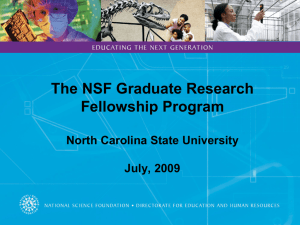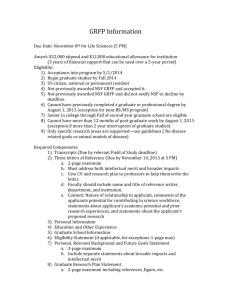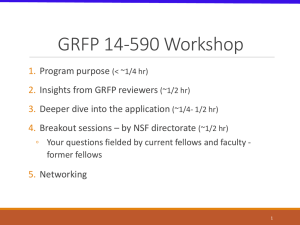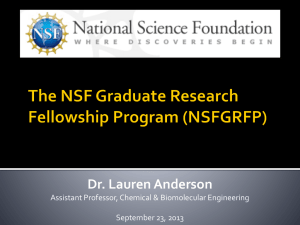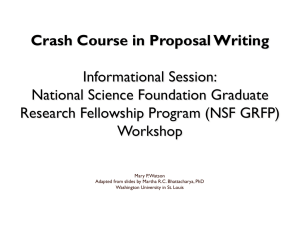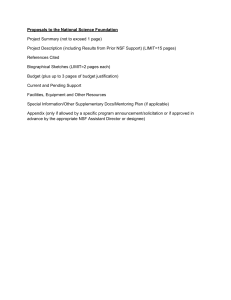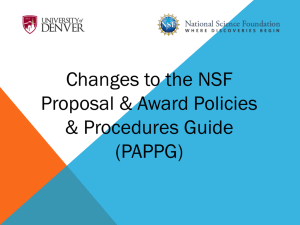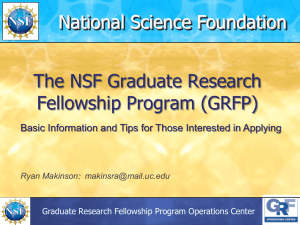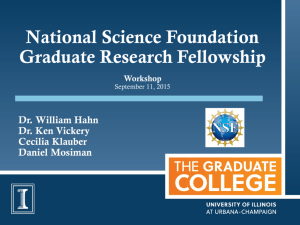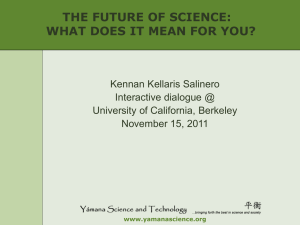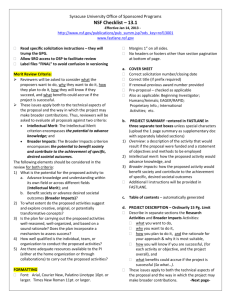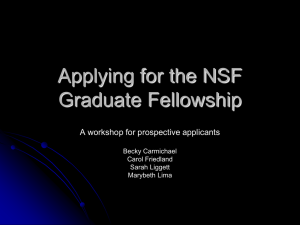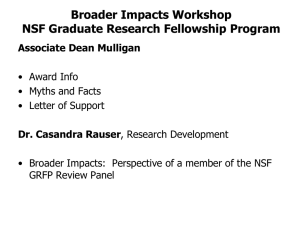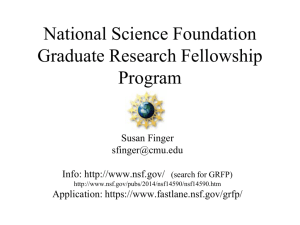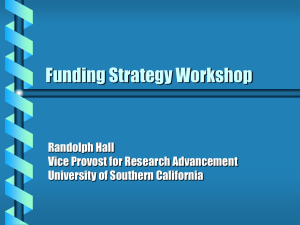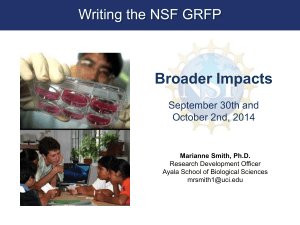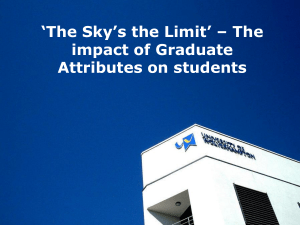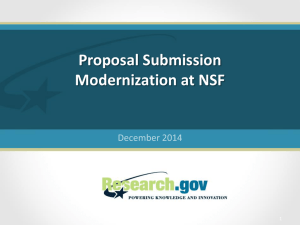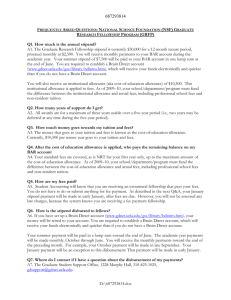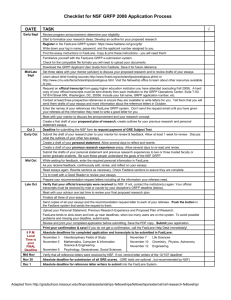NSF Graduate Research Fellowship
advertisement
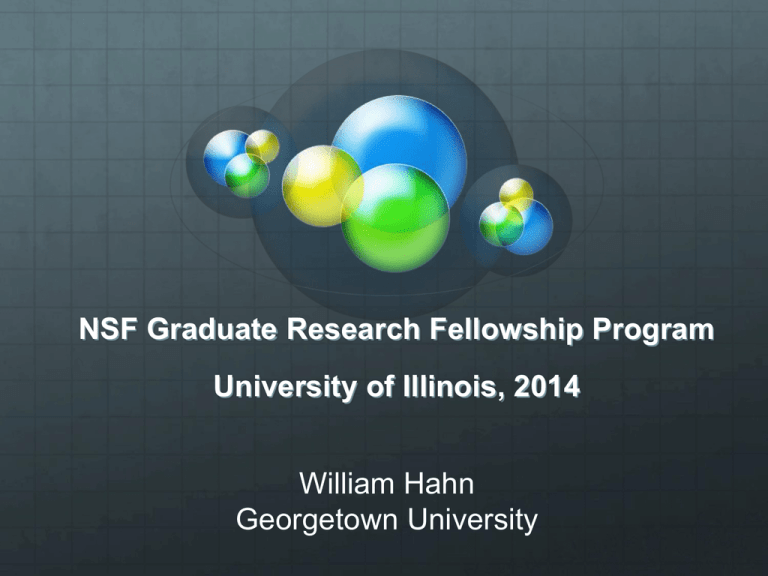
NSF Graduate Research Fellowship Program University of Illinois, 2014 William Hahn Georgetown University Overview of Presentation The National Science Foundation Purpose of the Graduate Research Fellowship Benefits and Eligibility Review Criteria Application Format Application Review Process Award Determination and Announcement The National Science Foundation Federal agency created in 1950 to “to promote the progress of science; to advance the national health, prosperity, and welfare; to secure national defense” Supports research and education in Science, Technology, Engineering and Math (STEM) disciplines - all fields but clinical biomedical areas (covered by NIH) NSF annually awards about 10,000 research grants, a proposed 2,000 new graduate fellowships (student as awardee), graduate trainees, and +/- 30,000 research assistantships (via grants to Principal Investigators) NSF Graduate Research Fellowship To increase the Nation’s human capacity in science and engineering by providing fellowships for early-career graduate students who pursue research-based master’s and doctoral degrees in NSF-supported disciplines To support the development of a diverse and globally engaged US science and engineering workforce NSF GRF Benefits (FY14 Solicitation) READ PROGRAM SOLICITATION CAREFULLY! (Normally released in late summer.) • Three years of support over a five year period • Annual stipend of $32,000 - cost of living to student • Tuition support of $12,000 - cost of education allowance paid to institution – remainder covered by university • Cyber infrastructure access via XSEDE • International opportunities through GROW initiative GRF Eligibility Criteria • Academic level o Level 1 - Seniors, baccalaureates with no graduate study o Level 2 - First-year graduate students o Level 3 - Second-year grad students (12 months of graduate study or less by Aug 1 prior to submission) o Level 4 - >12 months graduate study – extenuating circumstances • Historic success: Level 1>Level 2>Level 3>Level 4 • Citizenship o U.S. Citizen, National or Permanent Resident • Discipline o Research-based Masters or PhD in NSF-Supported Field of study (note changes in various fields, esp. BIO) NSF-Supported Disciplines • • • • • • • • • • • Engineering Computer and Information Science and Engineering Materials Research Mathematical Sciences Chemistry Physics and Astronomy Social Sciences (non-clinical) Psychology (non-clinical) STEM Education and Learning Life Sciences Geosciences Some Areas Not Supported • • • • • • Clinical work Counseling Business Management Social work Practice-oriented professional degree programs • Joint science-professional degree programs (MD/PhD and JD/PhD) • Medical, dental, law, or public health programs • Education (except researchfocused STEM education) Review Criteria • Potential to advance knowledge and understanding within field or across different fields (Intellectual Merit) and benefit society or advance desired societal outcomes (Broader Impacts) • Creative, original, or potentially transformative concepts • Plan is well-reasoned, well-organized, and based on a sound rationale • Plan incorporates a mechanism to assess success • Applicant is qualified to conduct the proposed activities • Adequate resources available for the proposed activities Intellectual Merit Criterion How important is the proposed activity to advancing knowledge and understanding within its own field or across different fields? How well qualified is the proposer (individual or team) to conduct the project? (If appropriate, the reviewer will comment on the quality of prior work.) To what extent does the proposed activity suggest and explore creative, original, or potentially transformative concepts? How well conceived and organized is the proposed activity? Is there sufficient access to resources? • Academic performance & background (grades, curricula) • Awards/honors • Communication skills • Research experience • International experience • Independence/creativity • Publications/presentations • Research plan • Choice of institution • References Broader Impacts Criterion • “Achievement of societally relevant outcomes” • Accomplished through the research itself, activities directly related to specific research projects or that are complementary to the project. • Full participation of women, persons with disabilities, and minorities underrepresented in STEM fields • STEM education and educator development at any level – increased public scientific literacy & development of STEM workforce • Partnerships between academia, industry, and others • Improved national security • Increased economic competitiveness of the US • Enhanced infrastructure for research and education Broader Impacts Criterion How well does the activity advance discovery and understanding while promoting teaching, training, and learning? How well does the proposed activity broaden the participation of underrepresented groups (e.g., gender, ethnicity, disability, geographic, etc.)? To what extent will it enhance the infrastructure for research and education, such as facilities, instrumentation, networks, and partnerships? Will the results be disseminated broadly to enhance scientific and technological understanding? What may be the benefits of the proposed activity to society? • Prior accomplishments • Community outreach • Impact on society and connectivity • Future plans • Leadership potential • Individual experiences • Integration of research and education • Potential to communicate to diverse audiences Application Materials GRFP FastLane Personal Statement, Relevant Background, and Future Goals Statement (3 pages incl. figs) Graduate Research Statement (2 pages incl. figs) Three Letters of Reference Transcripts (uploaded into FastLane) (GRE Scores NOT ACCEPTED!) Personal Statement, Relevant Background, and Future Goals • Three pages––provide the narrative of your story o Your motivation, preparation, & potential to contribute to scientific research, education, and innovation o Examples of leadership skills, creativity, perspective & unique characteristics (avoid arrogance) o How the GRFP will assist you with career goals • Opportunity for evaluators to see you as a person and understand what “makes you tick” • Chance to respond to broader impact merit criterion – How will you contribute to science and society? Relevant Background • Emphasize experience relevant to your application but include all examples of “research”, even if not in field • List experience with hypothesis formulation and testing, experimental design, data management and analysis, interpretation of results, dissemination of findings • Highlight what you did (independence) but discuss collaborators (teamwork) and leadership • A global worldview is important – mention international experience, collaborators, research opportunities, etc. • List any publications, posters, presentations, prizes, awards, grants, special recognition, etc. Graduate Research Statement • Introduce general theory/area of study and importance - a few references will demonstrate understanding of field • Panelists are experts in general field; may not be experts in your specific research specialty - avoid jargon • Describe your motivation to go into that area and discuss plans to prepare for that field of study - mention school(s), degree programs, potential advisor, etc. • Spell out specific details of your research and study plan but avoid jargon, specific experimental details, etc. • Comment on the broader impacts of your activities • Let the reader know of your career plans, even if tentative • Demonstrate flexibility (“plan B”) Letters of Reference • Three required - should know you as scientist and person • Will compare you with NSF Graduate Research Fellows & other successful students they have known based on: potential to make unique contributions to discipline, ability to conduct original research, leadership potential, productive member of scientific community, and originality of plan of study • Will state their role in assisting with the application • Provide referees sufficient time; share application materials with them; ask for advice • Track letters on FastLane - remind referees about deadline Panelist Review of Applications • Applications are sent to panelists in December allowing several weeks for review • Applications are scored numerically for overall merit by three panelists. Applications are also ranked by each panelist using standard NSF categorical ranks (poor/fair/good/very good/excellent) • Panelists comment on intellectual merit and broader impacts criteria highlighting strengths and areas for improvement – comments are provided to applicants Panel Review of Applications • Program office normalizes the numerical scores using a z-score approach and ranks applications by an average of these scores • Virtual panel sessions held in Jan & Feb to permit discussion and recommendations to NSF • Applications with inconsistent scoring (Z-score) are discussed and/or re-evaluated • Final ranking is primary determinant of award choice but NSF uses ranking and other factors to determine awardees and honorable mention Award Announcement Usually in late March or early April Awardees and recipients of Honorable Mention listed on the program FastLane website Final numbers dependent upon funding made available to the program office Success rates across disciplines not always equal Contact Information NSF GRF description, solicitation, and links: http://www.nsf.gov/grfp/ Online application, user guides, & official announcements: http://www.fastlane.nsf.gov/grfp/ Operations Center, Outreach, Helpdesk: http://www.nsfgrfp.org 866-NSF-GRFP (673-4737) help@nsfgrfp.org
